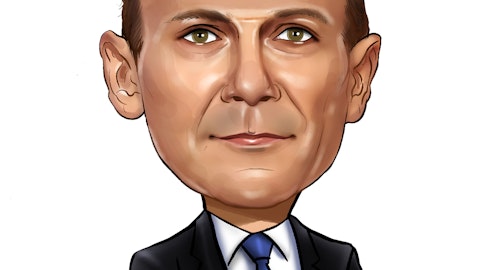Joe Bonaccorso: Yeah. So just to point you back, we were awarded the J-Code in January. So we have started already working through a fully baked communication plan with the insurance community and letting them know that the J-Code was awarded and we’re tracking now to see who starting to publish it, okay. So that’s been going on since January. We’re also working now to work with customers who are either currently buying down the miscellaneous J-Code or who have expressed interest in coming onboard to buy-and-bill, and the J-Code was final. And we’re working to get those offices set up ahead of April 1. And then as we continue to track towards April 1, we got several more communication blast go into the payer community. Post-April 1 we’ll continue to do that, just to make sure we have our top 150 payers squared away.
And it’s always boots on the ground, right? So we have our, we have our sales team out there. And they’re going to continue to make sure that the office is aware of the J-code itself. The J-code number, making sure that they have checked or insurance contracts to what their reimbursement will look like on the ASP plus side of it. And that’s always a deal. This is an account management drug, right? There’s always that reinforcement of education and knowledge that we share with customers every time we’re in the office in addition to our clinical sites.
Oren Livnat: Okay. And just to pivot real quickly to follow-up an earlier question about, how docs are using it? What do we, — and I know it’s quite early, but what do we know so far about retreatment rates? I know some patients have experienced clearance on one retreatment. So what are you seeing trend-wise, as we’ve tried to think about how to model this in terms of number — average number of treatments per patient? And on the insurance side, do you have any reason to believe that re-treatments will be treated any differently, from a…
Joe Bonaccorso: No.
Oren Livnat: … friction and payer perspective?
Joe Bonaccorso: Yeah. So let me take your last question first. We don’t see any impact on insurance reimbursement is what you’re asking on retreatment, right? When they approved our product, they knew it could be up to two applicators per treatment. And they knew it was for three treatments over 12 weeks. And we haven’t seen any real hard cap on the end of the four treatment of somebody did that three treatment let’s say, right. So, no, we don’t anticipate friction there from the Payer Community. Right now it’s early. But what we’re seeing is the typically two applicators per patient plus, we’re also early on using samples there, right. Starter doses to get them going as we’re building coverage. So the two plus two samples a pretty good spot to be in and we’re tracking towards, how we modeled our thoughts around driving demand. And what it would look like on a per-patient level as far as the applicator dose.
Oren Livnat: Okay. I’ll get back in the queue, if there is a question by me. Thanks.
Joe Bonaccorso: Okay. Thank you.
Operator: The next question we have is from John — Serge of Needham Company. Please go ahead.
Unidentified Analyst: Hi everyone. This is John on for Serge. Congrats on your progress. And thank you for taking our question. So regarding the upcoming Type C meeting for YCANTH Label Expansion in common warts, would you be able to provide any color on the potential design of this trial and whether or not additional trials would be conducted in an External Genital Warts and that’s include, investment required and any potential market opportunity for each of these indications? And second, can you provide any insight on how your partnerships with, Walgreens is structured and whether we’ll see any additional Specialty Pharmacy partnerships in the future? Thanks.
Ted White: So John thanks for the questions, but first but I’ll turn it over to Gary Goldenberg, our Chief Medical Officer.
Gary Goldenberg: Thanks Ted. For the Type C Meeting follow-up, regarding our common warts with the agency and I think the way that you could think about it, this is would be a typical Phase 3 program, that you would expect the agency to ask us sponsored to run? We are still in communications and look forward to come to us saying more as we continue to finalize the details of the trial design.
Ted White: And then the second, I think the other two questions you had was regarding Walgreens. So Walgreens, the partnership with Walgreens is accelerating nicely as it just to recall why we went to that, it gave us an opportunity to further expand our insurance network within the specialty pharmacy world, right, adding a second pharmacy. Walgreens also has 300 community health system stores, and we’re working towards getting those stores stocked with YCANTH, and that will give us a presence across 50 states when that initiative is complete, and we’re going to start doing that sometime later this quarter into the second quarter. And we’re always looking at our model, right? So what we really want to do here is be operationally efficient, and we want to think about ways to continue to ramp acceleration.
So your other question regarding potentially adding another specialty pharmacy, we’ll continue to assess that and see if there’s a need to further strengthen our footprint and help accelerate this. So that’s constantly under review by us.
Operator: The next question we have is from Kemp Dolliver of Brookline Capital Markets. Please go ahead.
Kemp Dolliver: Great. Thank you and good morning. So two questions. First, what’s the model for the pediatric sales force? I think I’ve seen it various times. We’re going to have, I think, a part-time pediatric sales force, and then I think I’ve also seen that this may be as evolved to where it’s a, you know, these are full-time hires with probably a compensation model that looks like the dermatology team?
Ted White: Yeah, so great question. You know, we were looking at a variety of models in pediatrics, knowing that we had to get there. But based on the inbound traffic, we continue to get to the office and what we’re hearing on the ground. We made the decision to staff that with a full-time, compensated field force. So, we’ll be building that team out to 20 representatives, and they will be hitting the ground in full April 1st. We think there’s a strong market opportunity with pediatricians, and we’ve decided to make that a full effort to go after it.
Kemp Dolliver: Okay. That’s very helpful. And the second question relates to sampling and just when you look at the sell-through data from FFF, how much of that volume is sampling and how much of that so far is reimbursed business?
Ted White: So when we look at sampling, that’s on a, that’s in a different lane for us, right? We’re not looking at that as our pull-through from FFF. So sampling has just been on an as-needed basis, based on the opportunity with the physician. If they were looking to treat the same day while, while we were getting our insurance coverage built out or they’re using the white bag specialty pharmacy, that has no bearing on what we’re doing at FFF as far as our revenue drive.
Kemp Dolliver: Okay. But just looking at the overall activity, are we looking at 80%, 90% sampling at this stage or a lower number?
Ted White: I’m sorry, I didn’t catch the last end of your question.
Kemp Dolliver: Well, let me rephrase it. What percentage of the volume so far is sampling?
Ted White: So what we typically do is, and I’ll try, I don’t have an approximate percent for you but what I would say to you the samples were have been tapering down significantly since we first launched the product in September-October, right? So meaning that September we were probably at our highest trying to get some of trial use and then now we’re bringing it down. So I would say it’s roughly maybe 5% — 6% of our activity out there is driven by sampling.
Kemp Dolliver: That’s perfect. Thank you.
Operator: The next question we have is a follow-up question from Oren Livnat of H.C. Wainwright. Please go ahead.
Oren Livnat: Thanks. Just a couple of squeezing. I guess to build on Kemp’s question maybe a different way to look at it and may be what you is getting at is, can you comment on gross-to-net? Ultimately you talked about Medicaid as an important part of the business. And — is it a new specialty pharmacy networks? Where is that shake out now and going forward?
Terry Kohler: Good morning. Thanks, Oren. Gross-to-net to-date have been very consistent with our expectations prelaunch. So going forward, we continue to expect that net sales as a percentage of gross sales is going to be in that 45% to 50% range, but there might be some lumpiness in that number throughout the year just depending on where patients are in their deductibles, but very consistent with what we thought prelaunch.
Oren Livnat: And do you expect that to improve as coverage and contracting come down through the year. And what’s the sort of terminal sustainable gross-to-net in mind?
Terry Kohler: Yes. We would expect that improved both these coverage comes on and we have less impact to our co-pay program for insured now covered as well as we transition more business to Buy & Bill, which is favorability from a distribution standpoint. So you’re probably even closer to 50% the higher end of that range that I gave you once we get to a normal state.
Oren Livnat: Okay. And lastly are you expecting significant response from the FDA in March to the Citizen Petition? How big a deal is this imported business now? And do you think they’re going to just kick the can on this 180 day response. Are you expecting something material and what might be the next steps?
Terry Kohler: Yes, Oren. We don’t expect them to kick the can. You know their response is due in April. We continue to have outreach with the FDA regarding our concerns and we fully expect to response to them.
Oren Livnat: Right. But do they — you think they actually do anything or are they going to acknowledge your concern — and we’ll keep it at that?.
Terry Kohler: Yes, If I if I knew that I’d win the lottery. We think we made a very strong argument in our citizen’s petition there is precedent for what we’re asking for and we hope that the FDA rules in our favor. But obviously I can’t predict what they’re going to do. But we’re confident, but we will be successful one way or the other.
Oren Livnat: Okay. Thanks so much. Good luck.
Operator: There are no further questions at this time. I would like to turn the floor back over to Ted White for closing comments.
Ted White: Thank you, operator. So I’d like to thank all of you for joining us this morning. We’re obviously very pleased with the significant accomplishments in 2023 and the progress we expect to make in 2024. And we look forward to providing another update on our first quarter earnings call in May. Thank you very much.
Operator: That concludes today’s conference. Thank you for joining us. You may now disconnect your lines.




